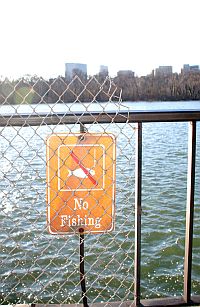If scientists are correct, 2048 will be a terrible year for sushi restaurants. And diners selling tuna melts, too.
 The End of the Line isn’t going to make you feel so good about hitting the neighborhood sushi bar.In fact, if I had any money to invest in a seafood venture, Carl Safina’s suggestion to “consider the jellyfishburger” may be the best advice. By mid-century, jellyfish may be the only “fish” left to catch.
The End of the Line isn’t going to make you feel so good about hitting the neighborhood sushi bar.In fact, if I had any money to invest in a seafood venture, Carl Safina’s suggestion to “consider the jellyfishburger” may be the best advice. By mid-century, jellyfish may be the only “fish” left to catch.
Though it lacks the starpower of a certain former vice president, The End of the Line does for the fish what Al Gore’s An Inconvenient Truth did for the climate: scare the pants off the viewer. The documentary deftly makes the case that industrial exploitation of the world’s fish stocks will result in the end of seafood by 2048, if not sooner, and that some species may already be in collapse.
Accompanied by many graphs, interviews with prominent marine scientists, and scenes of gruesome fishing practices, Charles Clover, a British journalist and narrator of this film, says that he first became aware of the dangers of overfishing when he mistakenly stepped into a meeting at The Hague in the early 1990s. “They said that trawling is like plowing a field seven times a year,” he said. “As a farmer’s son, I know that you can’t possibly plow a field that often and expect it to produce.”
The film particularly highlights the plight of the Atlantic bluefin tuna, whose breeding population may have already collapsed in 2007. Because high-end restaurants like Nobu fetch high prices for bluefin, some in the fishing industry have regularly ignored international quotas for the endangered bluefin, and the quotas themselves tend to be much higher than the science suggests.
In 2008, scientists recommended to the International Commission for the Conservation of Atlantic Tunas that quotas should be set at 10,00-15,000 tons of bluefin per year to regenerate the fish stock. ICCAT chose to set them at 29,000 tons. And the fishing industry? It hauled 61,000 tons anyway.
The last 20 minutes of the documentary, which offer suggestions for how consumers can make changes, feel like an afterthought. And after the powerful first 70 minutes, which effectively frighten viewers about the state of the world’s fish stocks, the consumer tips fall flat.
Though it’s predictably grim (what environmental documentary about the oceans is going to be reassuring?), there were some moments that took me by surprise. Did you know lobster is on the upswing? And some fishing practices in the United States (yes, the U.S.A.!) are considered on the cutting edge of sustainable practices? What’s more, any environmental documentary that ends with comforting words from former Alaska Sen. Ted Stevens certainly knows its, um, fishy business.
Gruesome, candid, and definitely not a date movie, The End of the Line is required viewing for anyone who’s ever snacked on the bounty of the sea.
Watch it: In honor of World Oceans Day, The End of the Line will show June 8 at the Seattle International Film Festival. Check the SIFF website for details.
For readers outside of Seattle, check the film’s website for many screenings in the U.S. and the U.K. during the month of June.



